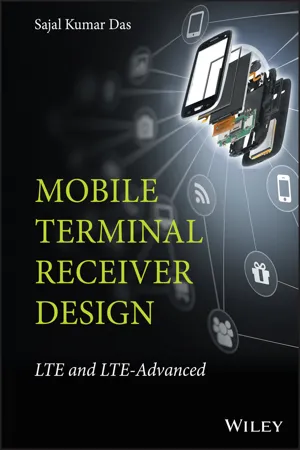
- English
- ePUB (mobile friendly)
- Available on iOS & Android
About This Book
MOBILE TERMINAL RECEIVER DESIGN
MOBILE TERMINAL RECEIVER DESIGN
LTE and LTE-Advanced
IndiaThis all-in-one guide addresses the challenges of designing innovative mobile handset solutions that offer smaller size, low power consumption, low cost, and tremendous flexibility, with improved data rates and higher performance. Readers are introduced to mobile phone system architecture and its basic building blocks, different air interface standards and operating principles, before progressing to hardware anatomy, software and protocols, and circuits for legacy and next-generation smart phones, including various research areas in 4G and 5G systems. Mobile Terminal Receiver Design
- explains basic working principles, system architecture and specification detailsof legacy and possible next-generation mobile systems, from principle to practiceto product;
- covers in detail RF transmitter and receiver blocks, digital baseband processingblocks, receiver and transmitter signal processing, protocol stack, AGC, AFC, ATC, power supply, clocking;
- features important topics like connectivity and application modules with differentdesign solutions for tradeoff exploration;
- discusses multi-RAT design requirements, key design attributes such as low powerconsumption, slim form factors, seamless I-RAT handover, sensitivity, and selectivity.
It will help software, hardware, and radio frequency design engineers to understand the evolution of radio access technologies and to design competitive and innovative mobile solutions and devices. Graduates, postgraduate students, and researchers in mobile telecommunications disciplines will also find this book a handy reference.
Frequently asked questions
Information
1
Introduction to Mobile Terminals
1.1 Introduction to Mobile Terminals

1.1.1 Building Blocks of a Smartphone
- Mobile terminal modem unit. This unit (cellular systems modem) interfaces with the cellular base stations, and sends / receives user information (voice, data) generated by the application unit. So it interacts with a base station using different cellular air interface standards like GSM, WCDMA, LTE etc. to send / receive information to distantly located called party or server. It also interacts locally with its application units, like speech, video, and data transfer applications for getting / providing the user application data. This is discussed in Chapters 2, 3 and 4. This consists of two main submodules: Radio Frequency (RF) unit and Baseband (BB) unit.
- RF unit. The RF analog front‐end unit’s transmitter circuit helps to upconvert the low‐frequency baseband signal to a high‐frequency amplified RF signal for transmission, and the receiver circuit helps to downconvert the analog amplified received high‐frequency signal to a low‐frequency baseband signal. The RF unit is discussed in detail in Chapter 6.
- Baseband unit. The baseband unit helps for digital bit detection, system protocol processing for proper and reliable communication with the network. These are discussed in detail in Chapter 4 and 5.
- SIM. A subscriber identification module (SIM) is an integrated circuit that securely stores the international mobile subscriber identity (IMSI) and the related key used to identify and authenticate subscribers on mobile telephony devices. A SIM circuit is embedded into a removable plastic card, called “SIM card.” This is discussed in detail in Chapter 5.
- Application unit. This unit is in charge of running various applications. It interacts with the modem and connectivity modules to send / receive information from remote devices, and uses that data to drive various applications. It provides the functions that users want to execute on the smart phone and these may include speech, audio playback, fax transmission / reception, Internet, e‐mail, Web browsing, image reproduction, streaming video, games, and so forth. This unit also handles the interface functions such as keyboard, display, and speech recognition, and it interfaces and manages other connectivity modules such as GPS and WLAN. Depending on the smartphone device complexity, there could one or several application processors in a mobile phone. The architecture design and selection details are provided in Chapter 5 and 7. The application processor consists of components like the processor core and device interfaces, which communicate with other peripheral devices attached to the application processor like the LCD screen, camera, keypad, universal serial bus (USB), and multimedia card (MMC) via interfaces. These are discussed in detail in Chapter 5.
- Peripheral devices. There are several peripheral devices placed in the smart phone for different purposes. Like, for data transfer with other devices or PC, an USB device is placed in the phone. Similarly, UART, I2S etc. are used for intermodule or interdevice communication. The other devices are like, SD / MMC, LCD display, keyboard, microphone, and speaker are also used in a mobile phone. These are discussed in detail in Chapter 5.
- Multimedia modules. It performs multimedia related functions like, speech encoding /decoding, audio encoding / decoding, video encoding / decoding by employing various multimedia standards (MP3, JPEG, MPEG, and so forth). As multimedia‐related functions are time consuming, so these are generally implemented in dedicated hardware block. Also, smartphone contain graphics processing unit (GPU) for rapid processing of multimedia functions. These are discussed in detail in Chapters 5 and 7.
- Various sensors and actuators. A sens...
Table of contents
- Cover
- Title Page
- Table of Contents
- Preface
- Abbreviations
- 1 Introduction to Mobile Terminals
- 2 Cellular Systems Modems
- 3 LTE Systems
- 4 LTE UE Operations Procedures and Anatomy
- 5 Smartphone Hardware and System Design
- 6 UE RF Components and System Design
- 7 Software Architecture Design
- 8 Battery and Power Management Unit Design
- 9 4G and Beyond
- Index
- End User License Agreement